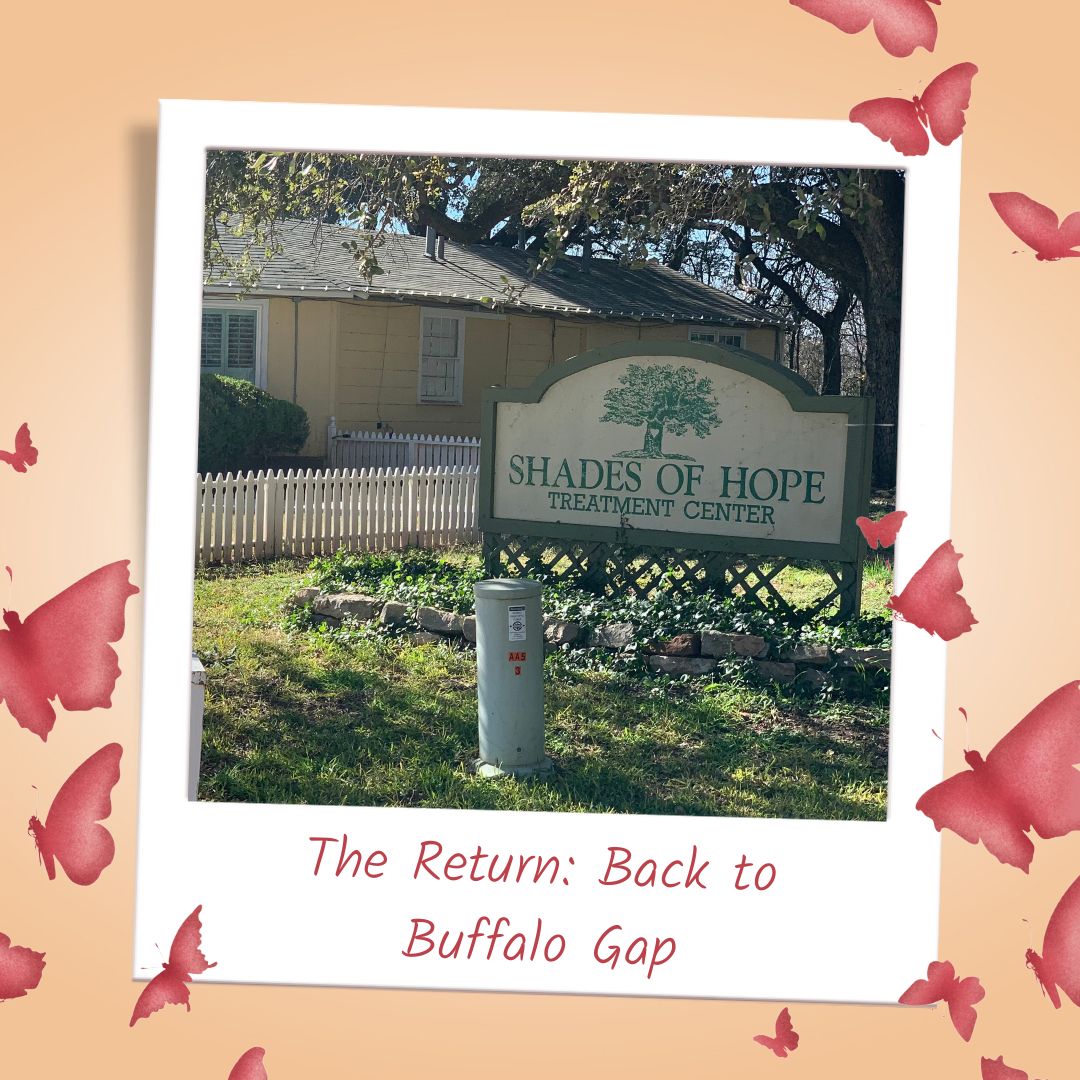
The Return: Back to Buffalo Gap
A hug can be as sincere as a toddler pleading for a cookie or as phony as reality television. At high school reunions, we squeal and lean our cheeks into each other, making sure no intimate parts of our bodies brush, as we pat each other gingerly on the backs. We shuffle compliments out like card dealers, oohing and awing over the appearances our long unseen acquaintances possess. We see colleagues at luncheons and carefully embrace, leaning our shoulders into each other, butts pushed back so the touch can’t be construed as anything more than a friendly business greeting.
The hug Kim McCarty gave me was sincere. It was transcendent in the way that people who have bonded together through the very worst of life’s experiences, healed together, survived together, clutch one another as we revel in the fact that we made it. We are soldiers of the same brigade, after being at war with our minds.
The deep pressure as we clasped and rocked each other from side to side, swaying like tree branches in a spring wind, was warm and sisterly. We were kin in recovery. As we held each other earnestly, I felt my homecoming.
“It’s good to see you.” My entire body let go, a full body sigh after entering a room where I knew only two people, Kim being one of them.
“You too.” Her voice sounded lighter, unburdened.
It had been seven years since I had seen Kim face to face. Her hair may have a few more strands of silver ,her slender, bare face and the black thin rimmed glasses were the same from my memory—not through posts on social media.
It had been eight years since I crossed the threshold of the Shades of Hope Treatment Center where Kim was a counselor. When I first met her, I could not bring myself to look her in the eyes. I was subjugated to shame as I sat wringing my hands on a sofa across from her and her mother, Tennie. Tennie had my intake forms on her lap, opened in a manilla folder, and I knew she’d read the unimaginable levels of trauma that happened to me and the very worst things I had done as a means to cope. It was May 2015 when my world-weary soul gave myself over to their care, believing it was my last chance at survival—survival of a mind that had made a plan to take its life the previous summer.
On this night in December 2022, I was back in Buffalo Gap, Texas where the yellow wood-framed buildings of Shades of Hope wait for substance abusers of all forms to enter. I returned for a fundraising event to support the Hope of Shades Foundation, the non-profit that provides financial assistance to those seeking treatment through the center.
As I drove the rental car around the curves and up the hills of Highway 83, it was like pulling out a photo album from the previous decade. My breaths slowed as the memories returned and my foot eased off the gas. Time had not touched the landscape, only nature’s seasonal clock had dotted the ridges with deep crimsons, amber and burnt orange foliage of fall. They were the same ridges I’d marveled at when I first arrived and saw the town nestled between them, the gap in those ridges, with a population of about 570. There was a Dollar General now and some upgrades to the local elementary school. But the arching of branches of denuded trees that created a halo over the treatment center were the same. Now older, their bark thicker with the secrets of the wandering souls that passed them by.
The first time I entered the township of Buffalo Gap, I was a patient. Much of my memoir, The Return Trip (Rising Action Publishing Collective, November 14, 2023), is set at Shades of Hope. It explores the six-day intensive trauma recovery I underwent for PTSD from years of sex abuse as a child and sexual assault as a preteen. As a result, I developed a list of symptoms that would rival the length of a CVS receipt in attempts to feel good or find validation: sex addiction, perfectionism, alcoholism, dissociative disorders and enough rage to fill the Grand Canyon. Six days that transformed my life and made it possible for me to come back to Buffalo Gap as an alumnus. This was my return for The Return Trip.
I checked into the same hotel in Abilene I’d stayed in the night before I had entered treatment. I didn’t feel an inflated amount of confidence as I swiped my room key and laid my cocktail dress on the bed. There was no dazzling charm to boast that I had my life together now despite the four-inch heels, red rouge and glittering earrings. I was humble. I was reverent. I knew my struggles with sobriety and recovery were a continuing odyssey.
There was something about seeing the road signs for Buffalo Gap that reminded me to stay mindful. I was nudged by memory to be cautious of the moments I believed I was standing on firm ground. I was aware as I drove to the event that Kim and Tennie McCarty knew the authentic version of me and cared for me all the same. There was no need for peacocking. If anyone knew I was ever full of it, it was these two women.
Three weeks before the night of the fundraiser, I’d spoken to Tennie by phone. Her voice was hoarse like the dirt and gravel of the West Texas prairies was merged with her throat. Her Texas accent put you on edge expecting a “bless your heart” to escape her mouth at any moment. That meant, by southern standards, you were either an idiot or you truly needed a gesture of endearment. She’d asked me during the call to meet for coffee with some directors of the Hope of Shades Foundation the day after the fundraiser.
Since I’d left treatment, I’d returned to a career in journalism, signed two book publishing deals and established the 1 in 3 Foundation, a nonprofit that provides counseling, support and recovery services to survivors of sexual violence who have little to no income. When I launched the foundation, Tennie gave the keynote address at our kick-off luncheon in 2016.
The temperature had plunged forty degrees overnight and I bundled up in my coat as I headed into the local café that looked like the saloons in the westerns my mom watched on television. Everything was made of wood, including the floor, and every mounted head on the walls had some form of fangs or antlers.
I met with some of the directors. There was a mutual respect for our journeys and the lives we had led that brought us to Shades of Hope. We discussed ways to provide more clients with help. Most patients can’t afford to stay for a full 42-day treatment and almost all need it. I had been one of those patients. My husband and I couldn’t cover the expense of a full stay because insurance doesn’t cover the treatment. As we drank coffee and ate buttery biscuits with thick cream gravy, we raged at the healthcare system that didn’t think something like family of origin sculpting and other body-based healing techniques (offered at Shades of Hope) were as effective as cognitive (talk) therapy.
After coffee, I drove through the streets of Buffalo Gap and to the neighboring community of View. It offered what it advertised. The countryside, those ridges and only a few residential properties in an expanse of the untouched west. It was cloudless on that frigid day, but as the rubber rolled over the pavement, braking slowly to a stop in a few places, I took in the streets where I had walked in silence after sobbing during the intensive. I stepped out of the car and snapped a few photos. We weren’t allowed to have our phones with us during the intensive. I snapped a visual to scroll to so I could remind myself, during those times when I felt I no longer needed the tools of sobriety, to look at the yellow paint, the white picket fences, and gravel driveways and remember—remember myself and my rock bottom.
That night we gathered for a surprise 80th birthday party for Tennie. I moved through the event venue, a restored warehouse, as she waved off everyone in both shock and delight, flailing her hands and scolding. Still, she covered her mouth like a shy school girl fighting off a blush. When she spotted me, she reached out and squeezed my wrist.
I’d been lying to her since I saw her the night before. I’d told a fib about how long I’d be in town to hide the party’s secret and made it seem like the casual Saturday I had planned was just a day of resting before going home to East Texas on Sunday.
“Did you know about this before last night?”
My grin was that of the Cheshire cat. “I did.”
“How long?” It sounded gruff as she narrowed her eyes at me, only making me laugh that we had pulled one over on a woman who was, in my opinion, a human lie detector.
“I knew for a few weeks,” I confessed.
She grumbled something inaudible over the DJ who was playing Motown and country music before rolling her eyes. “You know they did this for my seventieth birthday and I told them ‘Don’t you ever do that to me ever again.’ Shows how much my own kids listen to me.”
I laughed. “We are all just here to celebrate you. You deserve it.”
Tennie paused and I saw the sentiment in her gaze as her eyes surveyed the room. Family, friends, recovered addicts all conversing and gathered in her name. “There are people here I haven’t seen in 25 years,” she squeezed my wrist tighter once more in awe.
“Enjoy your night. This is all for you.”
“I’m so glad you are here.”
She squeezed my hand and walked away. I inventoried the crowd. I wasn’t family, but when I saw Kim she rushed to hug me again and said keeping the entire thing clandestine had taken the work of several magicians. I didn’t know if I could be labeled as Tennie’s friend. That felt too…lax. Tennie and Kim had saved my life through the solace of the center they had created.
Alumnus, former-patient, recovering addict, friend, ally, whatever moniker put to my relationship with the McCartys and the Shades of Hope Treatment Center, it is a connection that is my story. No abridged, Cliff’s Notes re-imagining of Maya’s life can cut out their place in my life or my moral debt owed to the center. I am alive and was able to write The Return Trip because of them.
Before leaving West Texas, I made one more stop and drove under the shade of the trees, rolling over the sandy backroads. As I clicked on my blinker and pulled out onto the interstate, I was thankful for the return that had brought a sober, healthier and happier Maya back to Buffalo Gap.
